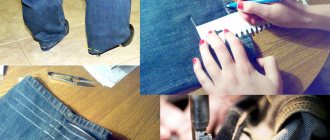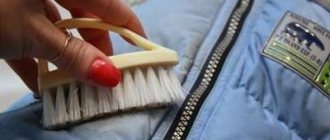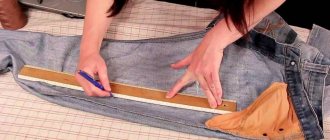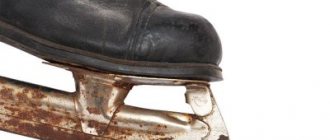How much can you tighten
There are several ways to determine exactly how many centimeters you can taper denim trousers:
- using a second pair of jeans. We select your favorite jeans that fit well. Turn both pairs of denim trousers inside out. Place two samples next to each other. Carefully draw a line of the future seam with chalk or a piece of sharpened soap and indicate the desired length of the product;
- using the fitting method. Turn jeans that require adjustments inside out. Carefully, so as not to prick yourself, secure the line of the future seam with pins. If necessary, adjust the length of the product. Take off your jeans and, using the pins as a guide, draw a seam line with chalk.
Pants can only be tapered to the knee. When determining the width of the trouser leg, be sure to take into account that jeans should be easy to remove, they should be comfortable to move around, sit down, and raise your legs. There is no need to narrow your trousers very much, as they will bunch up near the knee. Always leave a few centimeters of margin.
Model preparation
Before you start sewing jeans, you need to prepare the model for work. Pants can be hemmed not only from the bottom, but also in other places where it is necessary. If the goal is to narrow the item at the bottom, then the product is turned inside out and the bottom seams are ripped out, which are then ironed well.
It is worth noting that both women's and men's pants are sewn according to the same principle. The final result will depend only on the preferences of the person himself.
Note! The following life hack may help - before sewing in jeans at the waist, they should be washed at least once. This will prevent things from “settling” in the future.
Ironing things
Preparation for sewing at the hips consists of cutting the side seams (which are located higher), and to reduce the waist, the item is unzipped from the back. When ironing, special attention should be paid to the seams, so that later it will be easier to work with them. When cutting, it is important to be careful not to cut off too much or make a crooked line.
The following tips may be helpful when sewing:
- During work, you should try on the item several times to make sure there are no inaccuracies.
- If you have trousers in your wardrobe that match the required style, you can use them as a template.
- Don't rip your pants completely. Seams in the crotch area are quite problematic to sew on your own, especially for beginners.
- It’s worth specially purchasing strong threads if you don’t have them. Thin ones can tear at any moment, and all the work will be ruined.
- It is recommended to process the cut edges with an overlock or zigzag stitch, as denim tends to fray, and this will cause the item to suffer when worn.
You might be interested in: Rules for sewing a canopy for a crib yourself
Required Tools
One of the prerequisites for fast and high-quality work on how to narrow jeans from the bottom at home is the preparation of tools and materials.
For work you will need:
- sewing machine (preferably electric);
- overlock (if you don’t have one, you can use a zigzag stitch);
- tailor's scissors are the most suitable option for thick denim;
- tailor's chalk (you can use a sharpened piece of soap);
- iron (it’s good if it has a steam function);
- threads;
- sewing needles;
- long wooden ruler, measuring tape;
- ironing board.
How to sew on the sides?
Often the trousers are too big in the hip area, which spoils the whole impression of the outfit. To fit them to your figure with your own hands, use the instructions:
- Turn your jeans inside out and put them on.
- Pin to the desired size, remove and mark with chalk.
- Open the belt loops on the sides and open the side seams.
- Hand sew overcast stitches to the designated areas.
- Put your pants back on and make sure you're happy with everything.
- If the result is positive, you can start sewing on the machine. Don't forget to overlock the denim edge.
- At the very end, shorten the waistband to the desired length, sew and stitch back to the jeans.
- Remove all unnecessary threads.
Video: how to narrow jeans? Master Class.
Stages of work
Each stage of work on narrowing jeans requires accuracy and attention. Jeans are sewn along the internal and external side seams, along which decorative stitches run.
Along the side seams
After the denim trousers are prepared for work (ripped, ironed, turned inside out), you can begin the main stage of work - tapering.
Algorithm of actions:
- When trying on jeans, mark the places that need to be sewn in;
- secure the line of the future inner seam with pins;
- check again that the marks are correct. The product should fit well and not create discomfort when moving;
- place the denim trousers on a hard surface and carefully smooth out all the creases and uneven areas;
- Using tailor's chalk or soap, draw a seam line along the pin marks;
- baste denim with wide stitches;
- Try on the jeans again so that if necessary, you can correct any fit issues. If the trousers are very long, then first of all they are shortened, and only then sewn in;
- leaving seam allowances (1.5-2 cm), cut off excess fabric;
- using an overlocker (or using a zigzag stitch on a sewing machine) we process the cut edge. It is better to select threads to match the tone of denim. It is necessary to process the cut edges, since denim fabric is free-flowing;
- sew new seams, trying to make the transition from the old seam to the new one smoother;
- iron new seams on the ironing board;
- we process the bottom of the jeans. To do this, align the bottom edge of each leg. Considering that the edge is processed using the hem seam method, do not forget to leave seam allowances (3-4 cm).
Topstitching
To make the work look neat and finished, it is necessary to perform stitching.
Algorithm of actions:
- thread the machine into the thread to match the existing stitching;
- we lay a decorative seam that is as close as possible in stitch length to the factory seams;
- We iron each seam with a steam iron.
In order for the stitching to merge as much as possible with existing seams, craftsmen recommend:
- select thick threads (in some cases you can use two thin threads at the same time);
- you can use black threads in the shuttle;
- A special pad attachment for the ironing board will help you quickly and efficiently smooth out rough stitching seams.
For stitching, threads are selected to match those already on the product
How to narrow jeans at home
Everyone knows that wide jeans can be made into skinny ones in any sewing studio. However, everything is easy to do with your own hands and at home. In order not to spoil your favorite wardrobe item, it is important to consider several nuances:
- Denim fabric is quite rough, but fragile. Therefore, there is a need for mandatory processing of the edges, otherwise the trouser leg will gradually crumble.
- When sewing, you need to monitor the length of the needle steps so that the seams made by hand do not differ much from the factory ones.
- The sewing thread should also be as similar as possible to the one used to make the original stitches.
- To work at home, you will need to prepare the necessary items - scissors, chalk or soap, safety pins, sewing threads, a ruler.
How to taper jeans on the inseam
To narrow your jeans yourself, you don’t need to have extensive sewing experience. All you need to do is follow the instructions and not miss important points.
How to skinny jeans:
- First you need to turn your pants inside out.
- Open them along the inside seam and at the bottom (the length of the opened seam will determine the degree of tapering; for flared jeans, you can remove the seam to a maximum of the knee).
- The seam allowance area must be steamed with an iron so that creases are not visible.
- Try on jeans.
- Using pins, mark the places where the new seam should go. At the same time, it is important to take into account not only the appearance, but also your own comfort: it is recommended to take several steps in different directions, bend over, and sit down.
- Lay out the trousers on a hard, flat surface, trying to straighten out all the creases and folds.
- Use chalk to draw a straight line where the pins are located.
- Using contrasting threads and a needle, mark the future seam using the “needle forward” method.
- Try on the product again to identify possible defects and test again for wearing comfort.
- Take off the pants and use chalk to mark new lines, not forgetting to leave a 1.5 cm allowance from the stitching line.
- Trim off excess fabric.
- Overlock the edges with an overlocker or do a zigzag finish, choosing a thread color that is as similar as possible to the shade of the product.
- Press finished seams.
- Sew the product along the drawn lines, trying to connect the new and old seams as smoothly as possible so that the transition between them becomes invisible.
- Now you can stitch the bottom of the product. To do this, you need to align the cuts, mark an allowance of 4 cm, bend them and sew them using threads that match the tone of the finishing stitch.
- Steam all new seams with an iron using a pad or sleeve block.
- Trim the remaining threads.
- Turn the product inside out and try it on.
- If there are no flaws, you can completely iron your skinny jeans.
Recommended reading: How to lighten jeans evenly at home
How to properly taper jeans using old skinny jeans
You can make your jeans beautifully narrower in a simpler way by using trousers of the desired width. This method is suitable for those who are not confident in their abilities and cannot do the fitting “by eye”.
To narrow your jeans at home, you need to:
- Place the product to be changed on a flat, hard surface.
- Place trousers on top that are completely comfortable in width.
- Draw a line with chalk: the new seam will have to go along it.
- Using threads, baste the product.
- Try on pants.
- If there are no comments or feelings of discomfort, then the item should be removed and turned inside out.
- Cut off excess fabric, not forgetting the allowance.
- Sew the edges to prevent the jeans from fraying.
- Sew trousers, following all the recommendations described in the first method.
How to make skinny jeans from straight jeans using a pattern
The highest quality result at home can be obtained by using the third method of sewing up jeans, which involves using a pattern. To do this, you will need tight trousers, which will serve as the basis for the pattern. And wide jeans will need to be unraveled at the seams.
To narrow your jeans at home, you need to follow a number of steps:
- Place the ripped wide pants on a flat surface.
- Place the prepared pattern on top.
- Mark the fabric with chalk.
- Cut off excess material, remembering the need for an allowance.
- Using a temporary seam, sew the pattern along the lines.
- Try on the product. If all the nuances are taken into account, you can begin further finishing.
- Finish the seams with an overlocker.
- Sew the product.
- Steam with an iron.
- Try it on again.
Taper jeans at the bottom using old trousers
The procedure for tapering using old jeans is no different from the method of tapering at the side seams. The only difference is that the patterns for the new seams are jeans that fit well. Even if pattern jeans fit your figure without flaws, you must try on a new item before stitching.
Using a pattern
This is the most difficult method, requiring time and certain skills in work. But it is precisely this that allows you to get the highest quality result of perfectly fitting jeans. Also, the pattern method is well suited when you need to adjust several pairs of denim trousers at once.
Algorithm of actions:
- jeans that fit well are ripped out and the outline is transferred to a paper pattern;
- Wide jeans that require alteration are ripped out;
- place a pattern on the prepared canvas and trace it along the contour;
- with a seam allowance (2-3 cm), cut off excess fabric;
- new seams are sewn on a sewing machine;
- jeans are turned inside out, ironed and topstitched;
- fold and stitch the bottom of the product.
Features of processing the bottom of the product after narrowing the legs
After tapering, it is necessary to work clearly and carefully with the trouser legs. You must try to connect the old and new seams smoothly so that the transition is imperceptible. The entire lower part should be well ironed, all seams smoothed. To do this, you can use a special sleeve block or a hand-made pad.
Important Details
When using an overlocker, it is necessary to process the allowances on the front half of the trousers. The selection of threads must be carried out taking into account the color of the fabric. The stitch width on the machine for processing the lower part should be no more than 0.4 cm. In order to make a denser finishing stitch, you can use a double thread.
Without using a sewing machine
When you don’t have sufficient sewing skills, you can quickly narrow your jeans at the bottom using the following technique:
- put on jeans and stand in front of the mirror;
- Pin the trouser legs at the bottom with your hand to the required width;
- fold the excess fabric to the left side;
- holding the folded edge with your hand, roll up the trouser leg several times;
- evaluate the result obtained;
- do the same manipulations with the second trouser leg.
Using the tapering method without a sewing machine, you can experiment with the width and height of your jeans every day.
Tapering your jeans with your own hands is not difficult. The main thing is to act without haste, to follow a certain sequence.
Size down at the waist
If the width of the trouser legs suits you, but they are too wide at the waist, it is also possible to solve this problem yourself:
- Turn the pants to the left side.
- Using nail scissors, cut about 14-15 cm of the belt from the back center.
- If a company label is sewn in the belt loop area, then it will also have to be torn off.
- Open the middle and crotch seams (approximately 8 cm).
- After trying on the jeans, use safety pins to pin the areas that need to be reduced.
- Take off your clothes and draw these lines with chalk.
- Sew the fabric along the marks on the machine.
- Cut the waistband to the required length, leaving an allowance, sew it and stitch it in place.
Where to begin?
First, you need to understand what is required for the work and collect all the necessary elements:
- Sewing machine (manual or electric).
- Threads in two colors (to match the product and to match the stitching).
- Chalk, pencil or soap.
- Sharp scissors (preferably tailor's).
- Iron and ironing board.
- Overlock.
- Pins.
- Ruler.
- Sewing needles.
- Machine needle.
Prepare all the necessary materials that you will need for work so that you don’t get distracted by little things later.
Useful tips
To properly sew jeans along the inside or outside side seam, you should follow some recommendations:
- It is best to mark new side seams with chalk or soap, since these components are easily removed from the material by regular steaming.
- It is recommended to use white thread to mark the new side seam as it does not contain any dye and will stand out clearly on the jeans so it is easy to remove.
- At the end of the procedure, the product should be ironed so that the side seams and fabric unevenness are evened out.
- Not every home sewing machine is capable of sewing denim, so if the fabric is dense, you should contact a studio.
Recommended reading: How to remove lipstick from clothes











